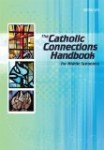 I am pleased to share the following interview with Maura Hagarty, editor of The Catholic Connections Handbook for Middle Schoolers
I am pleased to share the following interview with Maura Hagarty, editor of The Catholic Connections Handbook for Middle Schoolers![]() by Janet Claussen, Pat Finan, Diana Macalintal, Jerry Shepherd, Susan Stark, and Chris Wardwell. Maura was recently featured as a guest on our Catholic Moments Podcast and kindly shared the following Book Spotlight comments for our readers. Click here for your opportunity to win this wonderful resource for Catholic "tweens"!
by Janet Claussen, Pat Finan, Diana Macalintal, Jerry Shepherd, Susan Stark, and Chris Wardwell. Maura was recently featured as a guest on our Catholic Moments Podcast and kindly shared the following Book Spotlight comments for our readers. Click here for your opportunity to win this wonderful resource for Catholic "tweens"!
What prompted the creation of he Catholic Connections Handbook for Middle Schoolers![]() and how does it vary from other existing curricula for this "tweener" age range?
and how does it vary from other existing curricula for this "tweener" age range?
The creation of this new handbook was prompted by the success of a faith handbook for high-school aged teens published five years ago by Saint Mary’s Press. That book, The Catholic Faith Handbook for Youth![]() , presents the Catholic faith in a way that is very engaging for teens. The idea of creating something similar for young teens was a logical step for us.
, presents the Catholic faith in a way that is very engaging for teens. The idea of creating something similar for young teens was a logical step for us.
We have also created a religious education series for grades 6-8 that uses the Catholic Connections handbook as the core text. The series itself is called Catholic Connections. One way the program varies from other existing curricula is the use of one ungraded text across the middle school years. This approach offers leaders a tremendous amount of flexibility in designing their programs. It also puts a comprehensive presentation of the Catholic faith into the hands of young people.
 How can families put this book to use in their own homes to help their children in coming to a great understanding and appreciation of their faith?
How can families put this book to use in their own homes to help their children in coming to a great understanding and appreciation of their faith?
This book is an excellent tool for fostering faith conversations at home. Family life gives parents opportunities to know their kids, hear their questions, and see what’s going on with them day to day. Because of this, parents are in a unique position to help them relate the Catholic faith to their lives. One key is for parents to have a deep enough understanding of Catholicism so that they themselves can see these connections. The Catholic Connections Handbook for Middle Schoolers is youth-friendly, but it is not childish, and parents can learn from it too.
What is the format of the book and what work went into its creation and your moral and doctrinal research?
The book’s overall format echoes the structure of the Catechism of the Church (CCC) and the topics are drawn from the CCC – Creed, Sacraments, Morality, and Prayer. Like the CCC, our handbook offers a comprehensive presentation, but it does so in a way that makes the faith accessible to and appealing for young teens. The format of each chapter combines running text with engaging sidebars, photographs, and illustrations. Our research included getting feedback from young teens on the text’s readability and design during the book’s development.
This book contains a section on Christian morality and specifically addresses the issue of sexual respect in that light. How should parents prepare their children to address this sometimes difficult topic in a classroom or home setting?
I think it is helpful for parents to view education for human sexuality as a lifelong process for themselves and for their children. Parents that model respect and create an environment at home in which children feel comfortable asking questions set a good foundation for discussing this topic.
Given the pressures our kids today face in light of technological advances and the omnipresence of social networking venues, how must we, as the primary religious educators of our children, respond?
An important challenge for parents is to discover ways new technologies can help foster the faith formation and education of our children. I think there is a lot of potential in parents partnering with parish leaders, schools or other youth-serving organizations in this endeavor. Leaders who are committed to the task of religious education and are knowledgeable about technological advances can lead the way in making these discoveries.
How can parents compete with and set limits upon social networking, texting and chatting in their homes and is this important?
Setting limits and knowing what our children are doing is important. Kids need to learn how to be smart in their use of technology, and parental guidance is key. Parents can help kids discern the impact of their use of social networking technologies on their lives. One question to consider is whether their usage is helping them develop life-giving relationships or if it is impeding that process.
What responses are you getting from families, schools and parishes who are using this book?
The book has just been released, and the early response has been excellent. This is what Religion Teacher’s Journal has to say about the book:
"What an invaluable resource for middle schoolers and young teens--not to mention their catechists! This is a comprehensive look at all things Catholic but designed to make the "burden of study" light. It's colorful, beautifully laid out, and fully alive with interesting (and fun) bites about prayer, saints and holy people, and Catholic teaching."
Are there any additional thoughts or comments you'd like to share with our readers?
A great way to see what The Catholic Connections Handbook for Middle Schoolers![]() offers young teens is to take a look at the full-color samplers on our Web site (www.smp.org).
offers young teens is to take a look at the full-color samplers on our Web site (www.smp.org).
Maura Thompson Hagarty has been an editor at Saint Mary’s Press since 2005. She is a former parish youth minister and director of religious education. She lives in the Raleigh, North Carolina area with her family. She served, along with Brian Singer-Towns, as development editor for The Catholic Connections Handbook for Middle Schoolers, which was authored by a team of six writers: Janet Claussen, Pat Finan, Diana Macalintal, Jerry Shepherd, Susan Stark, and Chris Wardwell.
About the Author

Lisa M. Hendey
Lisa M. Hendey is the founder of CatholicMom.com, a bestselling author and an international speaker. A frequent radio and television guest, Hendey travels internationally giving workshops on faith, family, and communications. Visit Lisa at LisaHendey.com, on her Substack at LisaHendey.Substack.com, or on social media @LisaHendey for information on her speaking schedule or to invite her to visit your group, parish, school or organization. Find Lisa’s books on her Amazon author page.


.png?width=1806&height=731&name=CatholicMom_hcfm_logo1_pos_871c_2728c%20(002).png)
Comments